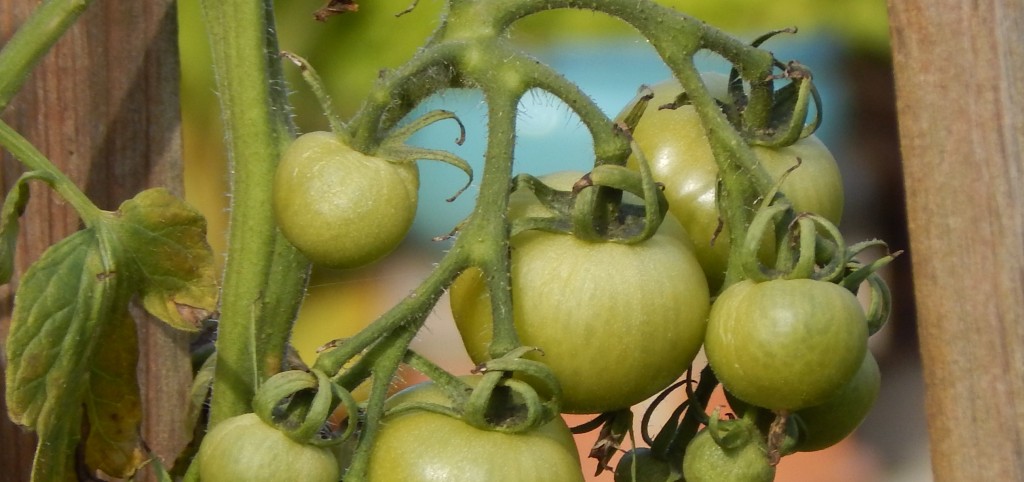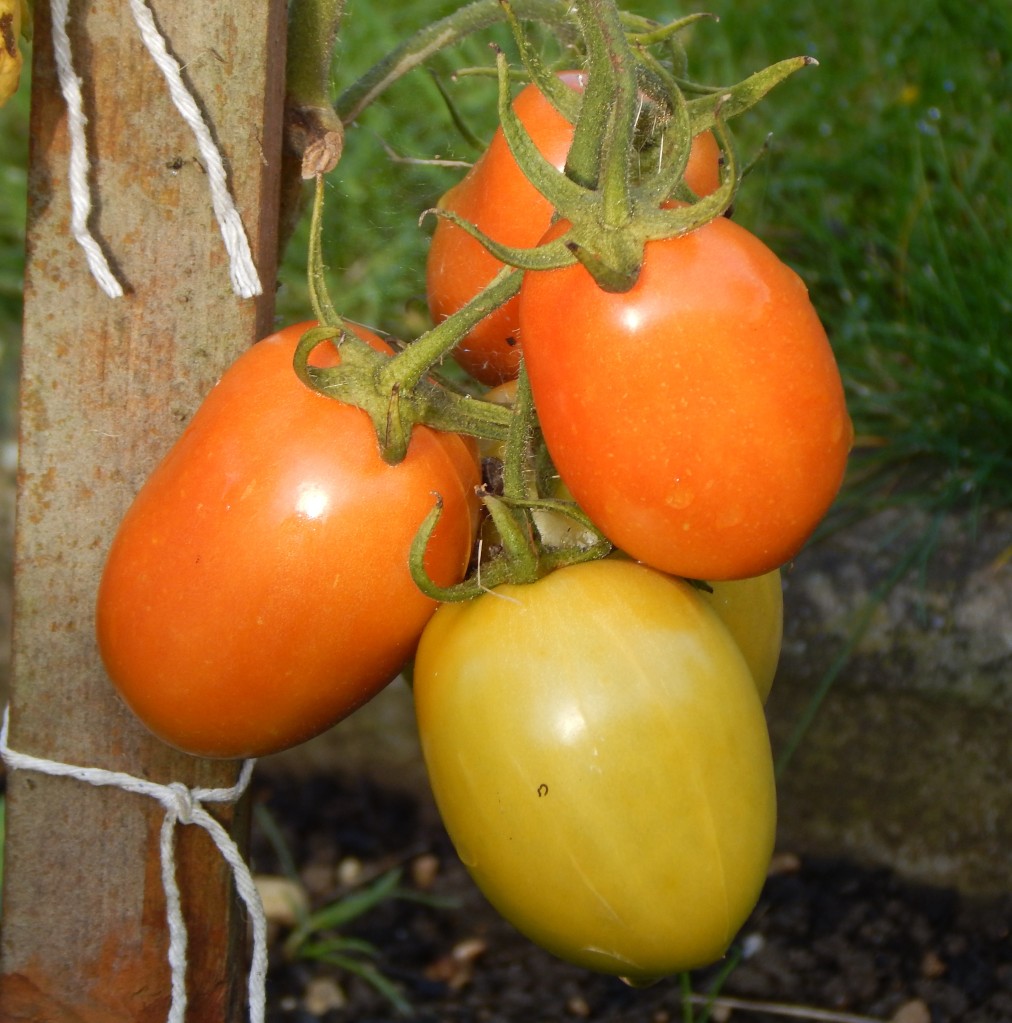
[318] Solanum lycopersicum, Tomato
Solanum melongena, Aubergine
Solanum tuberosum, Potato
Introduction
Solanum lycopersicum, the Tomato; Solanum melongena, the Aubergine; and Solanum tuberosum, the Potato, are three very widely grown familiar food crops closely related to [317] Bittersweet Nightshade.
Aubergines, not usually cultivated in the UK, are known as Eggplants in the USA.
You won’t be surprised, after [057] Rape, and [105] Courgette, that domestication since prehistoric times has led to varieties significantly different from those we saw yesterday – but you can recognize the tomato fruit as a much larger version of the fruit of Bittersweet Nightshade. Before domestication, the species from which these three are derived produced small green or yellow fruits.
This post will contain a lot of information, mostly from Wikipedia, and not many pictures.
Taxonomy
Kingdom – Plants
Division – Vascular Plants
Class – Angiosperms (Flowering Plants)
Order – Solanales
Family – Solanaceae
Subfamily – Solanoideae
Tribe – Solaneae
Genus – Solanum
Subgenus – See text
Section – See text
Scientific Names – [A] Solanum lycopersicum; [B] Solanum melongena; [C] Solanum tuberosum
Names
As for most domesticated crops, the name of the plant comes from the name of its cultivated fruits (or whichever parts are eaten.)
Tomato comes via Spanish from the native pre-Aztec name for the fruit, used originally for a related species.
Lyco-persicum, defining the species in 1753, comes from Greek roots wolf-peach. There is no obvious reason to associate it with either wolves or peaches – but in 1753 a tomato probably was more like a peach than it is now.
(You can see a little about wolves in [066] Dog and for peaches, see [280] Cherry, where you will, of course, see that persicum means Persian.)
Aubergine has a long history, coming via French and Catalan albergina from Arabic al-badinjan and Persian badenjan. the earlier Sanskrit vatigagama meant ‘plant that cures wind.’ Brinjal, used in parts of south-east Asia for the fruit, is cognate.
Melongena, the Mediaeval Latin name for the fruit comes via Italian and Ancient Greek melitzana from the same Arabic roots.
Eggplant comes from an early variety of aubergine that was white and shaped like eggs.
The word aubergine (and in America eggplant) can be used for the dark purple colour of the modern variety.
Potato also comes via Spanish from a South American native language. It was used originally for what we now call Sweet Potatoes (see below,) and for the Sixteenth and Seventeenth Centuries the word was used indiscriminately for both species.
The Latin word tuberosum meant lumpy. The botanical term tuber now has a precise definition associated with potatoes.
Solanum
The important things to remember from yesterday are that Solanum is a complex genus with many subgenera and sections and plants of different appearances. Today I will just look at the three main crop species.
[A] Tomatoes
Solanum lycopercisum was renamed as Lycopersicon lycopersicum in 1754 when several species were removed from Solanum. Following genetic analysis these species have been moved back and now form the Section Lycopersicon in the subgenus Solanum. They are types of Wild Tomato but normally only Solanum lycopersicum, the Common Tomato, is cultivated.
[This is a simplification. The subdivisions of Solanum are complex, fluid and not agreed universally. Lycopersicon is a more Greek version of the Latinized Greek word lycopersicum – and it gets round the prohibition of using the same word twice for genus and species of plants.]
Originally tomatoes were native to tropical highland areas of western South America. Their fruits were green and the size of peas. From about 500 BC or earlier they were cultivated in the Aztec Empire of Central America and bred selectively to make the fruits larger, sweeter and red. Even in 1500 AD, the Aztecs had many varieties with fruits of different sizes and shapes, coloured green, yellow or red.
They were brought back to Europe by the Spanish, producing small, yellow fruits that were seen as new types of Aubergine. (See below.) It reached Britain in 1590 and gradually came into culinary use.
They are now very widely cultivated in many varieties, usually in greenhouse environments. In the Twentieth Century, they were bred to produce forms that ripen uniformly red. Yield, disease resistance and shelf life have also been considered as more important than sweetness or taste.
China is the source of about a third of the overall production of tomatoes, with India, the EU, Turkey and the USA as other major contributors. Almost all varieties are Solanum lycopersicum but a few come from other closely related species.
The cultivated tomato plant, normally grown as an annual, can grow to two or three metres but has a weak stem that needs support. It is naturally a sprawling or climbing plant.

In Britain it is probably the most common food plant grown in vegetable plots in back gardens and in allotments. It is very easy to grow from seed or seedlings. We may not have good enough weather to ripen the fruits on their plants but the green fruit will gradually ripen indoors after picking.
Its stems are hairy and the leaf structure differs from other Solanum species but the completely yellow flowers are similar in structure.

The red fruits are berries, typically a few centimetres in diameter but different cultivars vary in size (and sometimes colour.) They start green and gradually turn to a bright red colour.





They are a classic example of the semantic twists of botany as in culinary terms they are treated as vegetables rather than fruits.
[B] Aubergine
The Aubergine, Solanum melongena from the subgenus – Leptostemonun, section – Melongena, is a domesticated species arising probably from Solanum incanum, known as the Thorn Apple or Bitter Tomato.
There have been two independent domestications in ancient India and East Asia. It was grown in China and the Mediterranean area from the Sixth Century, so it acquired Arabic and African names rather than Greek or Roman. It did not appear in Britain until the Sixteenth Century.
You are unlikely to see this plant growing in Britain so I will just say a little about its fruits. They are spongy in nature and In Europe and North America they are usually purple in colour. Like the tomato the fruits are generally treated as vegetables and they are almost always cooked before eating.
In India and other Asian countries, a much wider variety of cultivars can be found. Size may be much larger or smaller, shape can vary, and colours include white, yellow, green and from reddish purple to purple-black – with some striped varieties.
It is normally grown in tropical or subtropical climates with almost all World production coming from China and India.
[C] Potato
The Potato, Solanum tuberosum, from the subgenus – Solanum, section – Petota, has been cultivated for at least 7 000 years and is believed to have come from several species of wild potato still found in parts of South America, from the same subgenus and section. It was cultivated across the Americas by the time the Spanish arrived. They brought them back to Europe. Modern cultivation in the USA comes from plants derived from Europe. They are now the fourth largest food crop – after [364] Maize, [345] Wheat and rice.
Solanum tuberosum is a medium sized plant with plain leaf-shaped leaves. Its flowers can be pale pink, purple or blue, with the prominent yellow centres seen in other species of Solanum.




Its fruits look like small, green cherry tomatoes. Like most of the plant the fruits contain mild toxins and are unsuitable for human consumption.
After flowering, the roots form lumps called tubers and these are the potatoes that we eat. The stems and leaves die as the tubers develop. They come in many cultivated varieties coloured from light yellow to brown, or in shades of red and purple.
Plants can be grown from seeds or from the tubers (or just part of a tuber.) Those grown from tubers are clonally similar to the parent but those grown from seeds can be a mixture of varieties.
There are about 5 000 varieties of potato including 3 000 found only in the Andes. There are also about two hundred species or subspecies of wild potato, most of which hybridize easily with S tuberosum. Apart from S tuberosum, which produces almost all of the cultivated production, there are seven other species of Solanum sometimes used.
Nearly a hundred varieties are available in the UK and the potato is very popular for home production or in allotments.
They can be cooked in many ways and are widely used in food dishes. They may be used as fodder for livestock or to produce vodka and other alcoholic drinks.
Sweet Potato
Ipomoea batatas, the Sweet Potato, is a fairly distant relative of the potato that also has tuberous roots used as root vegetables. Several species of the genus Dioscorea, called Yams, produce similar root vegetables but are even more distant relatives. (In some parts of America sweet potatoes are called yams.)
Other Notes
The cultivated varieties of Solanum include some bushy varieties of Solanum tuberosum and its hybrids.
See also
The Chilli (or Chili) Pepper is a member of the family Solanaceae but is not in the genus Solanum.
